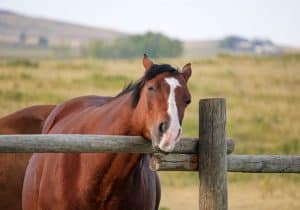A Pain in the Neck: Approaches to Cervical Spine Disorders In Horses

“The bones in the horse’s neck are quite extraordinary”, said DeNotta. “The seven cervical vertebrae have to collectively facilitate a wide range of motion in all directions, all while articulating precisely enough to never impinge the spinal cord, which travels in a narrow canal.”
An equine practitioner must consider whether a horse’s gait has its roots in the musculoskeletal or nervous system. “A lame horse will generally have a regularly irregular stride,” she said, “meaning it will show the same gait anomaly with each stride. A neurological horse, on the other hand, will have an irregularly irregular stride because it can’t perceive where its limbs are in space (i.e., proprioception is altered). Every stride may look a little different.”
Diagnosing Neurologic Issues in Horses
If the veterinarian confirms ataxia (impaired coordination), DeNotta begins a systematic neurological workup. “Don’t just start spinning the horse in circles,” she said. “Start with a thorough static and physical exam. Oftentimes, subtle clues in your physical exam can put a particular disease higher on your differential list, such as the ‘three As’ that point to equine protozoal myeloencephalitis (EPM): ataxia, atrophy, and asymmetry”.
She described her diagnostic process:
- Neurologic and physical examination. “Palpate the dorsal articular facets of the cervical vertebrae and check the horse’s range of motion (ROM),” DeNotta said. “If the horse can touch his hip with his nose, it has good ROM. If it resists bending or tilts his head and ‘dives’ for the treat, this can indicate neck pain.” During the dynamic neurologic exam, she assesses both coordination and proprioception. “The goal is to confirm and grade ataxia (using the 0-5 Mayhew ataxia scale) and identify the affected limb(s).”
- Cervical spine radiography. She uses this modality to check for abnormalities in the cervical vertebrae and articular process joints (also called facet joints) and assess the width of the spinal canal.
- Cerebrospinal fluid (CSF) collection. Healthy CSF is clear, colorless, with very few cells (0-5/µL), all of which are mononuclear. Total proteins in a horse’s CSF sample should be 40-90 mg/dL. DeNotta reminded her audience that evidence of intrathecal (within the central nervous system) antibody production against Sarcoystis. Neurona- the main protozoon responsible for EPM- is required to make an EPM diagnosis; titers, which measure . She also noted that the acute-phase protein serum amyloid A (SAA) is not a reliable diagnostic tool for EPM.
- Myelography. Cervical vertebral stenotic myelopathy (Wobbler’s syndrome) occurs due to spinal cord compression by misaligned vertebrae, or facet joint arthritis. Veterinarians can confirm spinal cord impingement with a contrast myelogram, which involves collecting radiographs under general anesthesia after a contrast agent is injected into the fluid around the spinal cord.
- Computed tomography (CT). “Newly available CT units capable of imaging an adult horse neck have greatly enhanced the understanding and diagnosis of cervical spinal disorders in horses,” said DeNotta. “CT allows for cross-sectional imaging of the entire neck, essentially allowing one to evaluate the vertebrae from all angles in 2D or even 3D”.
Causes of Neurologic Issues with Neck Involvement in Horses
There are three main diseases on a veterinarian’s radar when faced with a neurologic horse in which they suspect cervical spine involvement: EPM, Wobbler’s syndrome, and equine degenerative myeloencephalopathy (EDM). “Right now, EDM is a diagnosis of exclusion made by ruling out the other two, and can only be definitely diagnosed by post-mortem examination,” explained DeNotta.
She shared a tip she’s found helpful for managing EPM-affected horses: Administer Marquis (ponazuril) with ¼ cup of vegetable oil. In a 2020 study Furr and Kennedy recognized this simple practice can increase the bioavailability of the drug by up to 20%. “Marquis is a costly but very safe drug; its safety comes from the fact that it acts on organelles that protozoa possess, but mammals do not. Increasing its absorption and bioavailability with oil is a cost-effective way to promote high drug concentrations in the CSF.”

Written by:
Lucile Vigouroux
Related Articles
Stay on top of the most recent Horse Health news with















